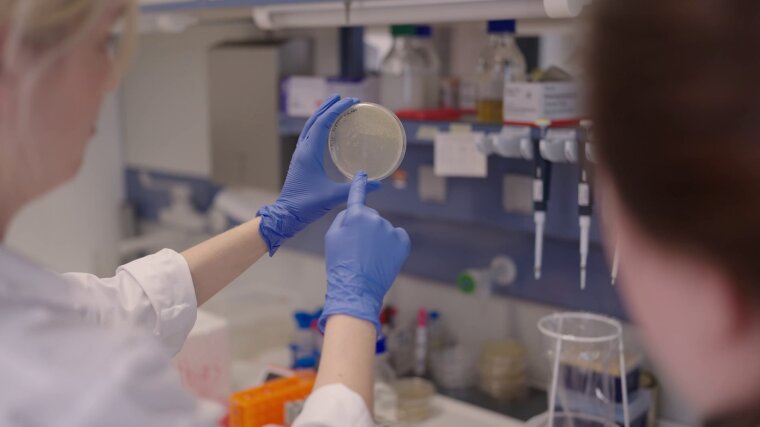
- Research
Published: | By: Juliane Seeber
Researchers at the Cluster of Excellence »Balance of the Microverse« at the University of Jena have discovered a previously unknown survival mechanism in bacteria. They found that the freshwater bacterium Caulobacter crescentus can change its nutritional strategy in a matter of seconds with the help of a special »RNA sponge«. This trick allows the microorganism to react rapidly to a shift from a nutrient-rich to a nutrient-poor environment—a decisive advantage for survival.
Caulobacter crescentus lives in nutrient-poor waters, where nutrient scarcity often arises suddenly. The big question addressed by the study, which was published in the journal Nature Communications, was: How does the bacterium manage metabolic switching so quickly when its food source dries up? The team, led by microbiologist Dr. Kathrin Fröhlich, discovered that the bacterium uses two tiny RNA molecules inside its cell as switches. As long as there is enough food, one of them, called SisA, maintains the cell’s standard metabolism. But as soon as the carbon availability drops, the second RNA molecule CrfA, kicks in: it acts as a molecular sponge, removing SisA from circulation. This clears the way for the »hunger genes« to switch on, and adjusts the cells metabolism so that it can survive famine conditions.
This molecular sponge mechanism is the key to the lightning-fast switch. »This mechanism is ingenious in its simplicity,« says Dr Kathrin Fröhlich. »We see how the bacterium readjusts its entire feeding strategy within minutes. This is a prime example of how elegantly bacteria control their genes.«
How the team made the RNA sponge visible
The researchers uncovered the mechanism using state-of-the-art molecular methods. With the help of a technique called RIL-Seq (RNA Interaction by Ligation and Sequencing), they were able to show for the first time that CrfA and SisA interact directly with each other, and work together as a team. Supplementary experiments with RNA-seq and RNA-reporter fusions revealed how the cells activate their genes as soon as nutrients are lacking. This made it possible to trace the entire switching process step by step.
Molecular resilience as the basis of the ‘microverse’
This discovery provides new insights into the resilience of microbial communities. The ability of individual microorganisms to respond quickly to stress or nutrient deficiency is the basis for the stability of entire microbial ecosystems—for example, in soil, water or the human gut.
Caulobacter crescentus is a model organism for the large group of alpha proteobacteria, which includes many medically and ecologically relevant species. The discovery thus provides a blueprint for understanding how microbes maintain their internal balance under changing environmental conditions.
»The resilience of microbial communities, which we are researching in the Cluster of Excellence ›Balance of the Microverse‹, begins at the single-cell level,« explains Kathrin Fröhlich. »A highly efficient mechanism such as the RNA sponge that we discovered shows how cells maintain their internal balance even under extreme conditions. Such mechanisms are a central building block for understanding how entire microbial ecosystems remain stable and adapt to changing environmental conditions—which is precisely the focus of our research in the cluster.«
Original publication:
Laura N. Vogt, Manuel Velasco Gomariz, Malte Siemers, Kai Papenfort and Kathrin Fröhlich: »An RNA sponge directs the transition from feast to famine in Caulobacter crescentus«, Nature Communications, 2025; DOI: 10.1038/s41467-025-65274-1, https://doi.org/10.1038/s41467-025-65274-1External link